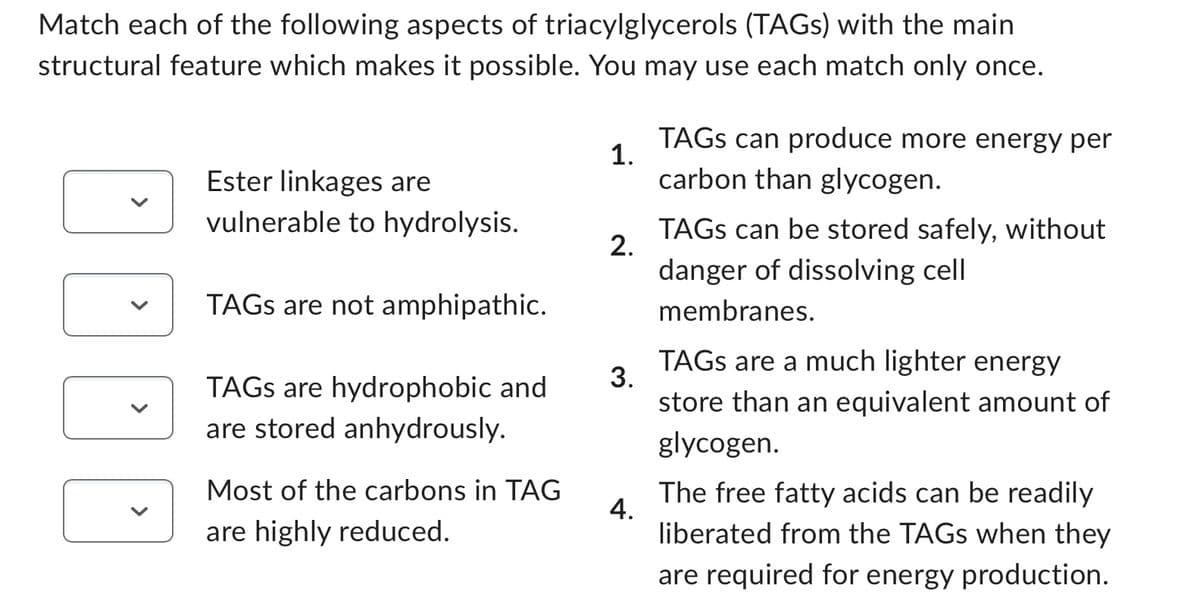Match each of the following aspects of triacylglycerols (TAGs) with the main structural feature which makes it possible. You may use each match only once. Ester linkages are vulnerable to hydrolysis. TAGS are not amphipathic. TAGS are hydrophobic and are stored anhydrously. Most of the carbons in TAG are highly reduced. 1. 2. 3. 4. TAGS can produce more energy per carbon than glycogen. TAGS can be stored safely, without danger of dissolving cell membranes. TAGS are a much lighter energy store than an equivalent amount of glycogen. The free fatty acids can be readily liberated from the TAGS when they are required for energy production.
Match each of the following aspects of triacylglycerols (TAGs) with the main structural feature which makes it possible. You may use each match only once. Ester linkages are vulnerable to hydrolysis. TAGS are not amphipathic. TAGS are hydrophobic and are stored anhydrously. Most of the carbons in TAG are highly reduced. 1. 2. 3. 4. TAGS can produce more energy per carbon than glycogen. TAGS can be stored safely, without danger of dissolving cell membranes. TAGS are a much lighter energy store than an equivalent amount of glycogen. The free fatty acids can be readily liberated from the TAGS when they are required for energy production.
Biochemistry
9th Edition
ISBN:9781319114671
Author:Lubert Stryer, Jeremy M. Berg, John L. Tymoczko, Gregory J. Gatto Jr.
Publisher:Lubert Stryer, Jeremy M. Berg, John L. Tymoczko, Gregory J. Gatto Jr.
Chapter1: Biochemistry: An Evolving Science
Section: Chapter Questions
Problem 1P
Related questions
Question

Transcribed Image Text:Match each of the following aspects of triacylglycerols (TAGs) with the main
structural feature which makes it possible. You may use each match only once.
Ester linkages are
vulnerable to hydrolysis.
TAGS are not amphipathic.
TAGS are hydrophobic and
are stored anhydrously.
Most of the carbons in TAG
are highly reduced.
1.
2.
3.
4.
TAGS can produce more energy per
carbon than glycogen.
TAGS can be stored safely, without
danger of dissolving cell
membranes.
TAGS are a much lighter energy
store than an equivalent amount of
glycogen.
The free fatty acids can be readily
liberated from the TAGS when they
are required for energy production.
Expert Solution
This question has been solved!
Explore an expertly crafted, step-by-step solution for a thorough understanding of key concepts.
Step by step
Solved in 3 steps

Recommended textbooks for you

Biochemistry
Biochemistry
ISBN:
9781319114671
Author:
Lubert Stryer, Jeremy M. Berg, John L. Tymoczko, Gregory J. Gatto Jr.
Publisher:
W. H. Freeman

Lehninger Principles of Biochemistry
Biochemistry
ISBN:
9781464126116
Author:
David L. Nelson, Michael M. Cox
Publisher:
W. H. Freeman

Fundamentals of Biochemistry: Life at the Molecul…
Biochemistry
ISBN:
9781118918401
Author:
Donald Voet, Judith G. Voet, Charlotte W. Pratt
Publisher:
WILEY

Biochemistry
Biochemistry
ISBN:
9781319114671
Author:
Lubert Stryer, Jeremy M. Berg, John L. Tymoczko, Gregory J. Gatto Jr.
Publisher:
W. H. Freeman

Lehninger Principles of Biochemistry
Biochemistry
ISBN:
9781464126116
Author:
David L. Nelson, Michael M. Cox
Publisher:
W. H. Freeman

Fundamentals of Biochemistry: Life at the Molecul…
Biochemistry
ISBN:
9781118918401
Author:
Donald Voet, Judith G. Voet, Charlotte W. Pratt
Publisher:
WILEY

Biochemistry
Biochemistry
ISBN:
9781305961135
Author:
Mary K. Campbell, Shawn O. Farrell, Owen M. McDougal
Publisher:
Cengage Learning

Biochemistry
Biochemistry
ISBN:
9781305577206
Author:
Reginald H. Garrett, Charles M. Grisham
Publisher:
Cengage Learning

Fundamentals of General, Organic, and Biological …
Biochemistry
ISBN:
9780134015187
Author:
John E. McMurry, David S. Ballantine, Carl A. Hoeger, Virginia E. Peterson
Publisher:
PEARSON